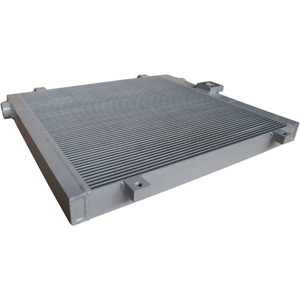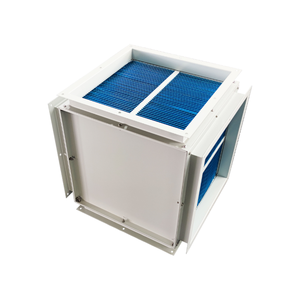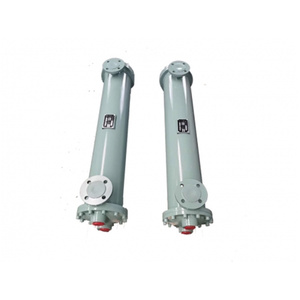
All categories
Featured selections
Trade Assurance
Buyer Central
Help Center
Get the app
Become a supplier

(1663 products available)



























An air compressor aftercooler is a type of heat exchanger fitted at the discharge point of the air compressor. Its main purpose is to cool the compressed air. This helps to reduce the building of condensation in the air piping and storage tanks. This is crucial as it helps to prevent damage to tools, hoses, and other equipment.
There are a couple of ways to classify an air compressor aftercooler. The first is by the method of cooling the compressed air. There are water-cooled aftercoolers and air-cooled aftercoolers. Water-cooled aftercoolers use flowing water to cool the compressed air. They are typically located near water sources. On the other hand, air-cooled aftercoolers use ambient air to achieve the same purpose. They are more popular than their water-cooled counterparts because they use less utility cost and water pressure.
Air compressor aftercoolers can also be classified according to the flow arrangement. This includes parallel flow aftercoolers and counterflow aftercoolers. In the parallel flow aftercooler, the compressed air and the cooling water move in the same direction towards the outlet. The parallel flow aftercooler achieves the best temperature inlet differential, but it may allow an overhead thermal drop. Counterflow aftercoolers on the other hand have the cooling water flowing upward while the compressed air is flowing downwards. The counterflow cooler utilizes a small space and is very efficient.
According to the design or configuration of the aftercooler, air compressor aftercoolers can be finned tube aftercoolers or shell and tube aftercoolers. The finned tube aftercooler is designed with a series of tubes that have elongated fins. The passing ambient air cools the tubes and the fins as the compressed air passes through. In addition to being space efficient, the tube and fin design allows for proper heat exchange. The shell and tube aftercoolers, on the other hand, have two typical components: the shell and the tubes. The shell or housing is a cylindrical metal vessel. Tubes are smaller than the vessel and have a number of holes on the shell. The compressed air flows through the tubes while the cooling fluid moves in the shell. Shell and tube aftercoolers are considered to be more efficient than finned tube aftercoolers.
Specifications for air compressor coolers vary based on types, models, and brands. Below are specifications of a typical air compressor cooler and their corresponding compressor maintenances.
Aftercooler Type
Aftercoolers are typically tube-and-shell heat exchangers. Sometimes, they could be tube heat exchangers, finned heat exchangers, or pancake coolers. Generally, the type depends on the size and design of the compressor. Regardless of the type, it is essential to inspect the aftercooler at least once every month. Inspect for signs of damage, leakage, or corrosion. Also, check whether the cooling fins and tubes are clogged with debris or dust. If so, schedule for cleaning immediately.
Materials
Many manufacturers use different materials, depending on their aftercooler design. Some common materials include brass, copper, carbon steel, and stainless steel. Materials require different maintenance methods. Manufacturers use steel or aluminum for aftercoolers, which are prone to oxidation and corrosion. Maintain the materials' integrity by regularly inspecting them for corrosion or damage. If there are any signs of damage, repair or replace them ASAP.
Coolant medium
The coolant medium for an air compressor cooler is usually air or water. If it's water, it could be distilled water or deionized water. Monitor the water temperature to ensure it falls within the recommended guidelines. If using water, ensure it's clean and uncontaminated. This prevents scale buildup and reduces corrosion.
Heat Transfer Method
An air compressor cooler transfers heat either by conduction or convection. Manufacturers design some models to transfer heat by both convection and conduction. Perform regular maintenance on the fins and tubes. Ensure there is a proper airflow to optimize the transfer of heat.
Dimensions
The dimension of the aftercoolers varies based on the air compressor model and manufacturer. Usually, the dimension will affect the weight. The aftercooler is bulky and heavy. It is ideal to inspect the aftercoolers' mounting brackets or hardware. Ensure they are secure and tight to support the weight and dimension.
Aftercooler Performance
The performance of an aftercooler is indicated by its capacity and pressure drop. The performance affects the aftercoolers' efficiency. Monitor the temperature and pressure of the aftercooler. Ensure it is within the recommended performance range to enhance its efficiency.
The main purpose of an air aftercooler is to cool compressed air. However, the benefits of an aftercooler extend beyond just cooling. Aftercoolers enable compressed air applications in several industries by reaping the benefits of cool compressed air.
Choosing the right air compressor cooler is essential for optimal performance and efficiency. Here are some helpful tips to consider when selecting an air compressor aftercooler:
Evaluate Compressed Air Flow:
The first step in choosing the ideal aftercooler is to determine the volume of the flow of cool compressed air that the cooler should handle. The amount of airflow that an aftercooler can handle is usually measured in cubic feet per minute or CFM. Consider the CFM rating of the air compressor aftercooler to ensure that it is capable of supporting the cool compressed air flow from the air compressor.
Identify the Compressed Air Temperature:
This involves examining the device operating environment to determine the likely ambient temperature or the temperature of the air being compressed. Different aftercoolers are designed to achieve varying degrees of cooling. Select an aftercooler that is built to lower the compressed air temperature to the level required for the intended purpose or downstream equipment.
Consider Space Constraints:
When selecting an air compressor cooler, it is essential to factor in the physical space available in the compressed air system. Some aftercoolers are designed with a more compact footprint to fit in tight spaces. However, the configurations and mounting options may differ, so ensure that the chosen aftercooler will precisely fit within the available physical space.
Evaluation of Cooling Efficiency:
This involves choosing an aftercooler with a cooling efficiency suitable for the intended application. It is important to select an aftercooler that can remove moisture from the compressed air to prevent downstream problems like corrosion, freezing, or contamination of pneumatic tools and equipment.
Consider the Type of Heat Transfer:
The aftercoolers available on the market may utilize different types of heat transfer, including air and water. Therefore, it is essential to choose an aftercooler that utilizes the kind of heat transfer suitable for the existing compressed air system and cooling requirements.
Maintenance Requirements:
It is crucial to consider the maintenance requirements of the aftercooler being selected. Different aftercoolers may demand different maintenance tasks, such as periodic cleaning, inspections, or replacing cooling fan bearings. Choose an aftercooler whose maintenance requirements are convenient and practical for the intended application.
Q1: What happens if an air compressor doesn't have an aftercooler?
A1: Without an aftercooler, the compressed air could remain hot throughout the entire system. This heat could cause various problems, including a higher risk of fires. Heating the pipe could also wear and damage the air tools, rubber fittings, and hoses.
Q2: Can an air cooler aftercooler have leaks?
A2: Leaks in an aftercooler are not uncommon, but they can be problematic. Even a small leak can reduce efficiency by allowing air to bypass the cooling coils. Larger leaks may result in coolant running out of the system. If a leaking aftercooler is ignored, it may cause damage to the compressor.
Q3: What is the difference between an air aftercooler and an air intercooler?
A3: Aftercoolers and intercoolers are similar in function. They both cool compressed air. However, intercoolers are typically found between stages in a multi-stage air compression system. Aftercoolers cool the air after it has been compressed in single-stage compressors.
Q4: Do aftercoolers drain water?
A4: Yes, the aftercooler must drain water. This is because water accumulates in the aftercooler while cooling the compressed air. If the water is not drained out, it may accumulate and lead to excessive water buildup, causing damage and reducing the efficiency of the air compressor.